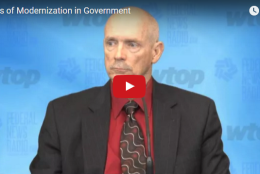Roundtables
Some believe federal networks seem to be in a perpetual state of disruption over the last 20 years. First agencies moved from the mainframe to the client server set-up. As soon as agencies seemed to have gotten this client-server approach down, in comes the managed services, which morphed really into cloud computing and the as-a-service approach to running networks. Now, we are in a third phase, some call it software-defined networking. Others say it’s part of the cloud evolution where the software running the network is really in charge and not the hardware.
July 08, 2016In “Meeting Government’s Mobile Mission,” Sean Frazier, chief technology evangelist for MobileIron’s Public Sector Practice, addressed three key points: mobile as the new normal, challenges and opportunities in the public sector and applications as the driver of mobility’s future.
July 06, 2016Over the past few years the federal government has become increasingly concerned about attracting and retaining its workers. To say that the government workforce is graying is an understatement, with figures from the Bureau of Labor Statistics showing that millennials make up less than a quarter of government employees. This discussion explored how advanced technology solutions in the areas of physical security, deployable solutions and cloud can be used to enhance the attraction, retention and productivity of workers.
June 27, 2016Five years after the launch of the administration’s “cloud first” policy, government chief information officers still face procurement, management and security obstacles when moving to the cloud.
June 14, 2016-
Federal shared IT and other services make all the sense in the world. So why aren’t more agencies doing it? And what will it take to expand use of shared services?
June 02, 2016 Protecting data on government networks is a critical component of our national cyber security strategy. Indeed, the Administration’s drive to strengthen federal cybersecurity calls for a re-examination of government’s legacy approach that requires every agency to build and defend its own networks. Agencies' concerns range from the use of encryption to the data explosion from the internet of things.
May 15, 2016It’s easy to set up a cyber-attack, but harder to defend against one. This was just one key point federal technology executives discussed on Federal News Radio’s panel, “Protecting the Front Line in Government Cyberattacks.” The panel took an in-depth look at the challenges federal IT executives face every day to keep federal networks safe and operational.
April 12, 2016With the growth of connected systems, commonly known as the Internet of Things, as well as better sensors and more devices, the amount of data agencies, and particularly the Defense Department, have to manage will only continue to grow.
March 28, 2016-
In the highly regulated world of federal IT, sometimes it seems as if every question is a yes-no, an either-or. Build or buy?
March 22, 2016 As agencies continue moving to the cloud, what’s the state of the migration in government today, and what opportunities and challenges remain? Those questions and many others were answered during the panel discussion, “Cloud in Government: Promise and Practice”.
March 01, 2016This panel discussion will focus on (1) how DOD is improving access to critical communications for the warfighter over the last year and (2) budgetary priorities to address future space-based mission needs.
November 20, 2015




